Abstract
Background
This study aimed to identify the potential molecular network associated with colon cancer metastasis.
Methods
A gene expression profile dataset (GSE40367) downloaded from Gene Expression Omnibus was used to identify and compare differentially expressed genes (DEGs) between primary colon adenocarcinoma tissues and matched tissue samples of liver metastases of colon adenocarcinoma. After the functional analysis of the DEGs, their protein–protein interactions (PPIs) were analyzed, and the transcription factors (TFs) and microRNAs (miRNAs) that regulated these DEGs were predicted. The data were used to construct an integrated network of DEGs, TFs, and miRNAs. Finally, the GSE68468 dataset was used to validate the DEGs associated with liver metastasis of colon adenocarcinoma identified in the GSE40367 dataset.
Results
Compared with the primary colon adenocarcinoma sample, 262 DEGs were upregulated and 216 were downregulated in the liver metastasis sample. The DEGs were primarily involved in functions associated with cell junctions and cell adhesion. The DEGs included 17 genes encoding TFs, and 39 miRNAs that regulated DEGs were predicted. Further analysis of the DEGs led to the identification of 490 PPIs. The data were used to construct an integrated network consisting of DEGs, TFs, and miRNAs. DEGs with a high degree of connectivity in the network included FGF2, ERBB4, PTPRC, CXCR4, CCL2, and CCL4. The network also revealed that FGF2 interacted with ERBB4, PTPRC, and CXCR4 and that PTPRC interacted with CXCR4. Furthermore, LCP2 and APBB1IP were predicted to target several other DEGs, including PTPRC, and miR-30a-3p and miR-30e-3p were predicted to regulate ERBB4 and several other DEGs. Notably, FGF2, ERBB4, PTPRC, LCP2, CCL2, and CCL4 were also identified as DEGs in the GSE68468 dataset.
Conclusion
The DEGs, TFs, and miRNAs identified in this study might play key roles in colon cancer metastasis.
Electronic supplementary material
The online version of this article (doi:10.1186/s12957-017-1181-9) contains supplementary material, which is available to authorized users.
Keywords: Colon cancer, Metastasis, Differentially expressed gene, Protein–protein interaction, Integrated network
Background
Colon cancer is a potentially fatal disease that affects more than a quarter of a million people each year [1]. Despite recent advances in the diagnosis and treatment of colon cancer, there were still 95,270 estimated new cases of colon cancer and 49,190 estimated deaths associated with it in the USA in 2016 [2]. Tumor metastasis is the primary cause of disease recurrence and death in patients with colon cancer [3].
In recent years, remarkable advances have been made in the study of the molecular mechanisms underlying colon cancer metastasis. CD44v6, a gene required for the colon cancer cell migration and generation of metastatic colon tumors, has been identified as a functional biomarker and therapeutic target of colon cancer therapy, and low levels of CD44v6 are associated with an increased probability of survival [3]. CCAT2, a novel long noncoding RNA transcript, is upregulated in microsatellite-stable colorectal cancer (CRC). CCAT2 enhances tumor growth and metastasis via miR-17-5p, miR-20a, and MYC [4]. In addition, nuclear β-catenin is resistant to FOXO3a-mediated apoptosis and promotes colon cancer metastasis [5]. Galectin-3 mediates resistance to tumor necrosis factor-related apoptosis-inducing ligand (TRAIL) by inhibiting TRAIL binding to death receptors, thereby promoting the metastasis of colon adenocarcinoma cells [6]. MicroRNAs (miRNAs) have also been shown to be associated with colon cancer metastasis. For example, miR-200 has been shown to mediate epithelial-to-mesenchymal transition (EMT) and metastatic behavior in colon cancer [7, 8]. miR-192 is able to inhibit the metastasis of colon cancer to the liver by downregulating the expression of several target genes, including Bcl-2, Zeb2, and VEGFA [9]. However, despite these findings, the molecular mechanisms underlying the metastasis of colon cancer, especially in the context of colon adenocarcinoma, remain incompletely understood. In addition, approaches for analyzing the differences between primary tumor lesions and their matched distant metastases remain unclear.
The present study’s aim was to investigate the molecular mechanisms underlying colon cancer metastasis. For the same, we used publically available gene expression data from metastatic colon adenocarcinoma samples to identify and characterize genes that are differentially between primary colon adenocarcinoma tissues and matched liver metastasis tissues. The putative functions and protein–protein interactions (PPIs) associated with the differentially expressed genes (DEGs) were analyzed, and transcription factors (TFs) and miRNAs that regulated the DEGs were predicted. The goal of the study was to identify novel metastasis-related DEGs in colon adenocarcinoma and provide insights into the mechanisms underlying colon adenocarcinoma metastasis, which could potentially inform further studies.
Methods
Data source
Gene expression profile dataset GSE40367 [10] was extracted from the Gene Expression Omnibus (GEO) database (http://www.ncbi.nlm.nih.gov/geo/). The data were analyzed using Affymetrix Human Genome U133 Plus 2.0 Array (GPL570, Affymetrix, Santa Clara, CA, USA). The dataset included data from 61 primary and metastatic tumor specimens. Data from 14 colon adenocarcinoma samples, consisting of seven endothelial samples from primary colon adenocarcinoma tissues and seven tumor endothelial samples from matched liver metastases were extracted for further analysis.
Gene expression profile dataset GSE68468 was also downloaded from GEO and analyzed using Affymetrix Human Genome U133A Array (HG-U133A-GPL96). This dataset comprised data from several types of samples, including primary colon cancer, polyps, metastases, and matched normal mucosal samples. Data from 185 metastatic colon cancer tissues and 14 colon carcinoma liver metastases were used for data validation.
Identification of DEGs
The Affymetrix CEL files were downloaded from GEO. The robust microarray analysis method [11] in the Affy package [12] was used for the initial processing of the data. This processing included background correction, quantile normalization, probe summarization, and translation of the probe ID to the gene symbol. Empirical Bayes statistics in LIMMA (Linear Models for Microarray Data, http://www.bioconductor.org/packages/release/bioc/html/limma.html) package in R (Version 3.0.0) provided by bioconductor software (http://bioconductor.org/help/search/index.html?q=R+software+/) [13] was utilized to calculate the significance (P value) of the differences in expression of the DEGs between the primary tumor tissues and the matched metastatic tissues. A P value of <0.05 was selected as the cutoff criterion for defining DEGs.
Functional enrichment analysis
The online tool called Database for Annotation, Visualization, and Integrated Discovery, (DAVID; version 6.7; http://david.abcc.ncifcrf.gov/) [14] was used to conduct the Gene Ontology (GO) functional enrichment analysis for cellular components (CC), biological processes (BPs), molecular functions (MFs), and the KEGG (Kyoto Encyclopedia of Genes and Genomes) pathway analysis. A P value of <0.01(calculated using Fisher’s exact test) and gene count >2 were set as the cutoff criteria for the GO functional enrichment analysis. A P value of <0.05 and gene count of >2 were chosen as the cutoff criteria for the KEGG pathway enrichment analysis.
PPI network construction
PPIs among the DEGs were identified using the STRING (Search Tool for the Retrieval of Interacting Genes; http://string-db.org/) database, which integrates a large number of known and predicted protein interactions [15]. PPIs with a combined score of >0.4 were used to construct the PPI network, and the network was visualized using Cytoscape (http://cytoscape.org/) [16]. Network modules were extracted from the original PPI network based on MCODE analysis [17]. The default parameters (K-Core, 2; degree cutoff, 2; max. depth, 100; node score cutoff, 0.2) were used as the cutoff criteria for the identification of network modules. The GO functional and KEGG pathway enrichment analyses of genes in the modules were conducted using the threshold values described above.
Prediction of DEG regulators
TFs that regulate the DEGs identified were predicted using integrated TF platform (ITFP), which contains a large number of mammalian TFs and their targets [18].
miRNAs that regulate the DEGs identified were analyzed using WEB-based gene set analysis toolkit (Webgestalt; http://www.webgestalt.org) [19]. The threshold number of genes targeted by a regulatory miRNA was defined as ≥4. The threshold P value (calculated by Fisher’s exact test) was set at <0.01.
Construction of an integrated network
The integrated network consisting of PPIs, TF-DEG pairs, and miRNA-DEG pairs was visualized using Cytoscape. The connectivity degree of the nodes in the network was calculated according to the scale-free property of the network.
Data validation
Dataset GSE68468 from the GEO database was used to validate the DEGs identified in GSE40367. The DEGs were screened using the same method and threshold values. DEGs common to both datasets were determined using a Venn diagram.
Results
Identification and characterization of DEGs
Compared with the primary samples, 262 genes were upregulated and 216 genes were downregulated in the metastasis samples. The hierarchy cluster analysis of the DEGs was able to distinguish the two groups of samples (Fig. 1), confirming the reliability of the results for subsequent analysis.
Fig. 1.
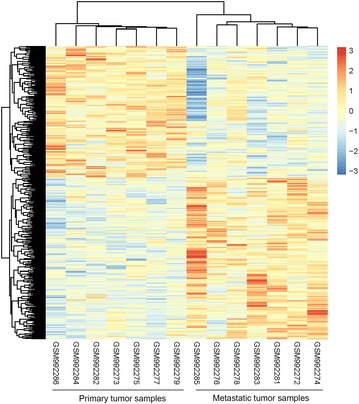
A heatmap of DEGs between primary colon adenocarcinoma tissues and liver metastases. Each row represents a single gene, and each column represents a sample. The labels below represent the sample number in the dataset. Red represents upregulation, and blue represents downregulation
The biological functions of the DEGs were analyzed using GO and KEGG pathway functional enrichment analyses. The DEGs were predicted to be significantly associated with pathways related to cell adhesion molecules (P = 0.03) and pyrimidine metabolism (P = 0.03), as well as several GO functions, including leukocyte activation (P = 0.002), extracellular structure organization (P = 0.005), cell junctions (P = 0.001), and cell adhesion (P = 0.00015; Fig. 2) (Additional file 1).
Fig. 2.
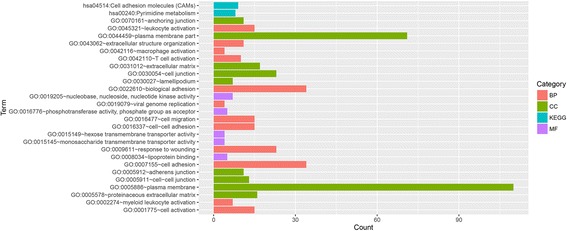
The results of the GO and pathway enrichment analyses of the DEGs. BP biological process, CC cellular component, MF molecular function, KEGG Kyoto Encyclopedia of Genes and Genomes, GO Gene Ontology
Analysis of the PPI network and modules
Putative PPIs associated with the DEGs were investigated PPIs using STRING. A total of 490 PPIs involving 70 DEGs were identified (Fig. 3). According to the PPI network, FGF2 interacted with ERBB4, PTPRC, and CXCR4 and PTPRC interacted with CXCR4.
Fig. 3.
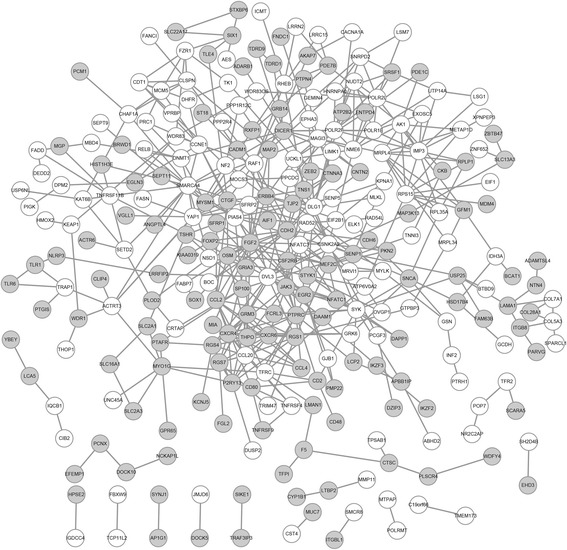
The PPI network of DEGs. Gray nodes represent upregulated genes, and white nodes represent down regulated genes. Nodes represent proteins, and lines represent PPI pairs. The degree of connectivity of each node reflects the number of nodes that interact with it
A total of 10 modules in the PPI network met the cutoff criteria. The two modules (modules 1 and 2) with the highest scores and several additional nodes were selected for further analysis. Module 1 included 10 DEGs (nine upregulated genes and one downregulated gene), including CXCR4, CXCR6, C-C Motif Chemokine Ligand 2 (CCL2), CCL4, and CCL20 (Fig. 4a). Module 2 also comprised 10 DEGs (one upregulated gene and nine downregulated genes), including RPLP1, RPL35A, RPS15, and MRPL4 (Fig. 4b).
Fig. 4.
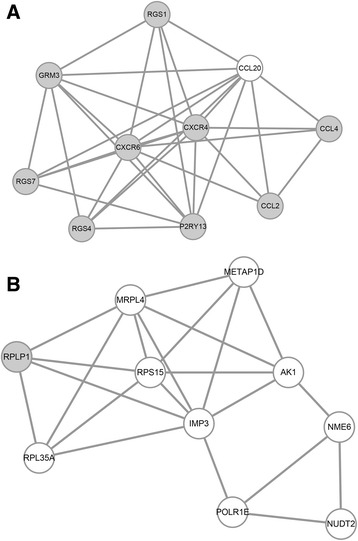
Modules identified in the PPI network of DEGs. a Module 1 and b module 2. Gray nodes represent upregulated genes, and white nodes represent downregulated genes
The functional enrichment analysis revealed that DEGs in module 1 were significantly enriched for factors associated with chemokine signaling (P = 0.000025) and cytokine–cytokine receptor interactions (P = 0.000095), as well as several GO functions, including cell surface receptor linked signal transduction (P = 0.00015), G-protein coupled receptor protein signaling (P = 0.03), and immune responses (P = 0.00068; Fig. 5a). DEGs in module 2 were markedly enriched for pathways associated with ribosomes (P = 0.00011) and pyrimidine and purine metabolism (P = 0.0049), as well as several GO functions, including ncRNA metabolism (P = 0.005) and ribonucleoprotein complex biogenesis and translation (P = 0.004; Fig. 5b) (Additional file 1).
Fig. 5.
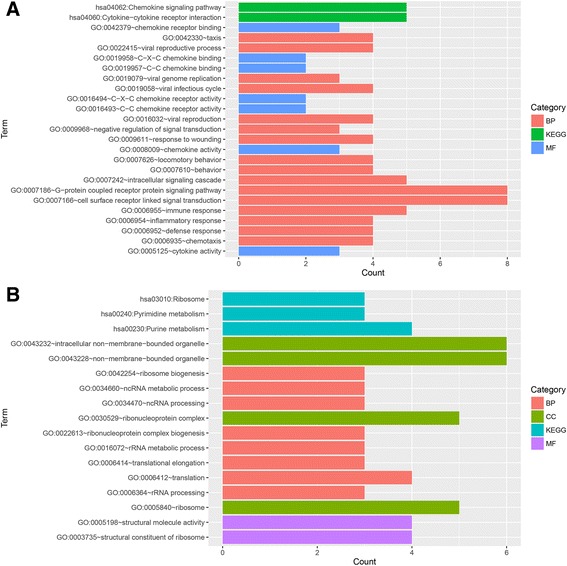
The results of the GO and pathway enrichment analyses of DEGs in module 1 (a) and module 2 (b). BP biological process, CC cellular component, MF molecular function, KEGG Kyoto Encyclopedia of Genes and Genomes, GO Gene Ontology
Prediction of regulatory TFs and miRNAs
We also investigated TFs and miRNAs that potentially regulate the identified DEGs. Seventeen DEGs encoded TFs that targeted other DEGs. Five DEGs encoding TFs (ADARB1, APBB1IP, ARHGAP25, LCP2, and MCM5) that targeted more than five genes (Table 1) were selected for further analysis. A total of 39 miRNAs predicted to regulate the DEGs met the cutoff criteria. The 17 miRNAs associated with the 10 lowest P values (e.g., miR-506, miR-330, miR-17-5P, and miR-124A) targeted a total of 88 DEGs (Table 2).
Table 1.
The transcription factors targeting more than five differentially expressed genes
| TF | Target | Score | TF | Target | Score |
|---|---|---|---|---|---|
| ADARB1 | ATP2B2 | 0.0431271 | LCP2 | AIF1 | 0.0485591 |
| ADARB1 | C17orf51 | 0.0453939 | LCP2 | APBB1IP | 0.0500103 |
| ADARB1 | ICMT | 0.0576544 | LCP2 | CCL4 | 0.0490895 |
| ADARB1 | LMAN1 | 0.0474452 | LCP2 | CSF2RB | 0.0501211 |
| ADARB1 | RPLP1 | 0.0452993 | LCP2 | EVI2B | 0.0544675 |
| ADARB1 | SULT1C2 | 0.0493526 | LCP2 | MNDA | 0.0509129 |
| APBB1IP | AIF1 | 0.0558902 | LCP2 | MS4A6A | 0.0476156 |
| APBB1IP | CD48 | 0.0580736 | LCP2 | PARVG | 0.0486343 |
| APBB1IP | LCP2 | 0.0500103 | LCP2 | PTPRC | 0.0510363 |
| APBB1IP | MYO1G | 0.0496366 | MCM5 | CDT1 | 0.0528149 |
| APBB1IP | NCKAP1L | 0.0529768 | MCM5 | CHAF1A | 0.0556453 |
| APBB1IP | PTPRC | 0.0576564 | MCM5 | DNMT1 | 0.0530079 |
| ARHGAP25 | OR5L2 | 0.0474039 | MCM5 | FANCI | 0.0524277 |
| ARHGAP25 | PARVG | 0.0495445 | MCM5 | LRRFIP2 | 0.0442217 |
| ARHGAP25 | PTAFR | 0.0442268 | MCM5 | PRC1 | 0.0563632 |
| ARHGAP25 | PTPRC | 0.0448310 | MCM5 | RAD54L | 0.0507543 |
| ARHGAP25 | SYK | 0.0486975 | MCM5 | SPARCL1 | 0.0495283 |
| ARHGAP25 | WDFY4 | 0.0452244 | MCM5 | TK1 | 0.0516265 |
TF transcription factor
Table 2.
The top 10 results of predicted microRNAs with a lower P value
| MicroRNA | Target gene count | Adjusted P value |
|---|---|---|
| hsa_GTGCCTT, miR-506 | 22 | 0.0004 |
| hsa_TGCTTTG, miR-330 | 14 | 0.0004 |
| hsa_GCACTTT, miR-17-5P, miR-20A, miR-106A, miR-106B, miR-20B, miR-519D | 20 | 0.0004 |
| hsa_TGCCTTA, miR-124A | 18 | 0.0005 |
| hsa_ACTGAAA, miR-30A-3P, miR-30E-3P | 10 | 0.0006 |
| hsa_ATACTGT, miR-144 | 10 | 0.0006 |
| hsa_AATGTGA, miR-23A, miR-23B | 15 | 0.0006 |
| hsa_ACTGTAG, miR-139 | 8 | 0.0006 |
| hsa_AGCATTA, miR-155 | 8 | 0.0008 |
| hsa_GCATTTG, miR-105 | 9 | 0.0008 |
Analysis of the integrated network
The PPIs, TF-DEG pairs, and miRNA-DEG pairs were used to construct an integrated network comprising 323 nodes and 785 relation pairs (Fig. 6). miRNAs and DEGs with the highest degree of connectivity included miR-506 (degree = 22), FGF2 (degree = 20), miR-106A (degree = 20), and SMARCA4 (degree = 19). The degree of the TF-encoding genes LCP2 and MCM5 was 15 (Table 3). In addition, the network revealed that LCP2 and APBB1IP targeted several DEGs, including PTPRC, and that miR-30a-3p and miR-30e-3p regulated several DEGs, including ERBB4.
Fig. 6.
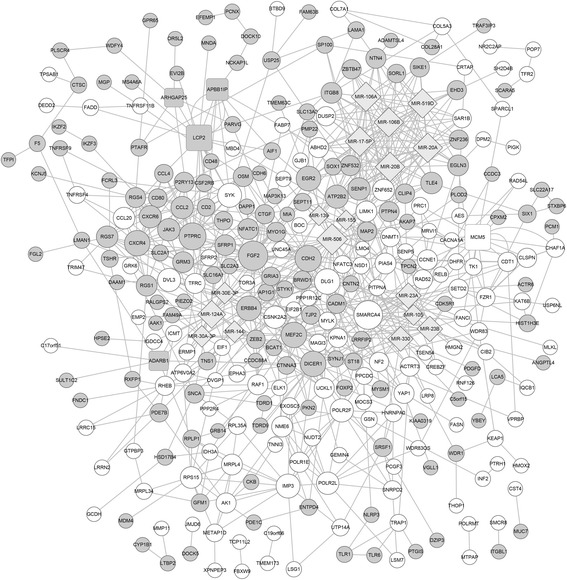
The integrated network consisting of DEGs, TFs, and miRNAs. Round and rectangular gray nodes represent upregulated genes, and round and rectangular white nodes represent downregulated genes. The rectangular nodes represent TFs, and diamonds represent miRNAs
Table 3.
The nodes with a degree at least 10 in the integrated network
| Node | Degree | Node | Degree | Node | Degree | Node | Degree |
|---|---|---|---|---|---|---|---|
| miR-506 | 22 | CDH2 | 16 | miR-330 | 14 | SENP1 | 11 |
| FGF2 | 20 | CXCR4 | 15 | IMP3 | 13 | APBB1IP | 10 |
| miR-106A | 20 | DICER1 | 15 | SYK | 13 | CCL20 | 10 |
| miR-106B | 20 | DLG1 | 15 | ATP2B2 | 12 | miR-144 | 10 |
| miR-17-5P | 20 | LCP2 | 15 | DVL3 | 12 | miR-30A-3P | 10 |
| miR-20A | 20 | MCM5 | 15 | POLR2F | 12 | miR-30E-3P | 10 |
| miR-20B | 20 | MEF2C | 15 | CCL2 | 11 | RGS7 | 10 |
| miR-519D | 20 | miR-23A | 15 | CSNK2A2 | 11 | RPS15 | 10 |
| SMARCA4 | 19 | miR-23B | 15 | CXCR6 | 11 | TLE4 | 10 |
| miR-124A | 18 | EGR2 | 14 | JAK3 | 11 | ZNF652 | 10 |
| PTPRC | 17 | ERBB4 | 14 | POLR2L | 11 |
Data validation of the DEGs
A total of 5537 DEGs were identified in the comparison of non-metastatic colon carcinoma samples and metastasis samples from the GSE68468 dataset. Among them, 147 genes (e.g., FGF2, ERBB4, PTPRC, LCP2, MCM5, CCL2, CCL4, RPL35A, and MRPL4) were identified in both GSE40367 and GSE68468 (Fig. 7).
Fig. 7.
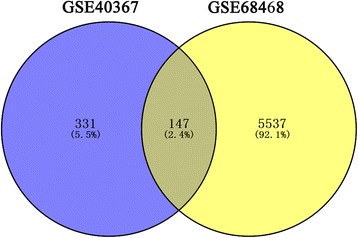
The Venn diagram showing the overlapped genes in both GSE40367 dataset and GSE64486 dataset
Discussion
The present study identified 262 genes that were upregulated, and 216 genes were downregulated in liver metastasis samples compared with matched primary colon adenocarcinoma samples. In the integrated network constructed from these data, DEGs with the highest degree of connectivity included FGF2, ERBB4, PTPRC, and CXCR4. FGF2 was predicted to interact with ERBB4, PTPRC, CXCR4, CCL2, and CCL4, whereas PTPRC was predicted to interact with CXCR4.
FGF2 encodes fibroblast growth factor 2, a protein with mitogenic and angiogenic activities, which contributes to tumor growth [20]. FGF2 is highly expressed in metastatic CRC [21], consistent with the results of the present study. FGF2 promotes CRC cell migration and invasion via integrin αvβ5-mediated adhesion and FGF receptor-SRC signaling [22]. The IC50 of 5-fluorouracil (5-FU) decreases in cells deficient for FGF2 compared with control CRC cells in vitro [23]. Moreover, high FGF2 expression levels are correlated with a lower response rate to 5-FU and overall survival in CRC patients [23]. These results indicate that FGF2 plays an important role in colon cancer metastasis. In this study, FGF2 was predicted to interact with ERBB4, PTPRC, CXCR4, CCL2, and CCL4. ERBB4 encodes Erb-B2 receptor tyrosine kinase 4, a member of the epidermal growth factor receptor subfamily. ERBB4 is overexpressed in human colon cancer and promotes cellular transformation [24]. A previous study found that ErbB4 and the metastasis-enhancing gene KAI1 C-terminal interacting tetraspanin (KITENIN) can upregulate c-Jun and promote CRC cell invasion [25]. ERBB4 was predicted to be regulated by miR-30a-3p and miR-30e-3p. A previous study reported that miR-30A inhibits EMT in lung cancer [26], suggesting that low levels of miR-30A might enhance EMT in cancer. PTPRC encodes a member of the protein tyrosine phosphatase (PTP) family, which comprises proteins commonly activated in tumors [27]. Consistent with the results of the present study, CXCR4 (C-X-C motif chemokine receptor 4) is highly expressed in metastatic colon cancer in the liver compared with primary colon cancer tissue, and elevated CXCR4 expression levels contribute to poor survival [28–30]. CCL2 is upregulated in metastatic CRC and functions as a prognostic marker of liver metastasis due its role in recruiting myeloid cells [31]. CCL4 has also been shown to play a crucial role in metastatic CRC via interactions with the receptor CCR5 [32, 33]. No other studies have reported an association between PTPRC and colon cancer metastasis. However, the PTP family member PRL-3 is associated with CRC metastasis to the liver and CRC prognosis [34, 35]. As PTPRC was predicted to interact with CXCR4, we speculated that PTPRC may also be involved in the metastasis of colon cancer to the liver. In this study, PTPRC was predicted to be targeted by TFs encoded by the upregulated genes APBB1IP and LCP2. APBB1IP encodes a Rap1-GTP-interacting adaptor molecule. Rap1-GTPase activation mediates breast cancer cell migration [36], and activated Rap1 can promote prostate cancer metastasis [37]. LCP2, also referred to as SLP-76, promotes T-cell development and activation [38]. To date, no other studies have reported an association between APBB1IP and LCP2. However, both genes targeted PTPRC, and PTPRC interacted with FGF2. The aforementioned studies indicate that FGF2 plays an important role in colon cancer metastasis. Therefore, APBB1IP, LCP2, and PTPRC might also play a role in colon cancer metastasis.
Despite the significance of our findings, several limitations to this study are worth noting. The results are solely predictions; therefore, they should be confirmed by laboratory data. Furthermore, our findings should be confirmed in a larger sample size. The expression patterns of the genes identified in the present study should be validated by large-scale studies in the future. Furthermore, the interactions among the DEGs identified and their relationship with the predicted regulatory TFs and miRNAs should be confirmed.
Conclusions
In conclusion, we identified 262 upregulated and 216 downregulated DEGs in liver metastases originating from colon adenocarcinoma and used these data to construct a network of DEGs, regulatory TFs, and miRNAs. Genes that played a prominent role in this network included FGF2, ERBB4, PTPRC, CXCR4, CCL2, and CCL4. The set of DEGs also comprised genes encoding TFs, including APBB1IP and LCP2, and miRNAs, including miR-30a-3p and miR-30e-3p. This is the first evidence supporting a role for PTPRC, APBB1IP, LCP2, miR-30a-3p, and miR-30e-3p in colon cancer metastasis. These findings might provide new information that can serve as the basis for future experimental studies.
Acknowledgements
None.
Funding
None.
Availability of data and materials
All data generated or analyzed during this study are included in this published article.
Authors’ contributions
SC participated in the design of this study and drafted the manuscript. HW performed the statistical analysis. MY helped draft the manuscript. All authors read and approved the final manuscript.
Competing interests
The authors declare that they have no competing interests.
Consent for publication
Not applicable.
Ethics approval and consent to participate
Not applicable.
Publisher’s Note
Springer Nature remains neutral with regard to jurisdictional claims in published maps and institutional affiliations.
Abbreviations
- BP
Biological process
- CC
Cellular component
- CRC
Colorectal cancer
- DEGs
Differentially expressed genes
- EMT
Epithelial-to-mesenchymal transition
- GEO
Gene Expression Omnibus
- GO
Gene Ontology
- ITFP
Integrated TF platform
- KEGG
Kyoto Encyclopedia of Genes and Genomes
- MF
Molecular function
- miRNAs
MicroRNAs
- PPIs
Protein–protein interactions
- PTP
Protein tyrosine phosphatase
- TFs
Transcription factors
Additional file
Result of functional enrichment analysis. (XLSX 24 kb)
Footnotes
Electronic supplementary material
The online version of this article (doi:10.1186/s12957-017-1181-9) contains supplementary material, which is available to authorized users.
Contributor Information
Songtao Chu, Email: chusongtao0705@163.com.
Haipeng Wang, Email: hpwang1978@163.com.
Miao Yu, Phone: +86-0431-84997820, Email: yumiao0305@163.com.
References
- 1.Sears C, Garrett W. Microbes, microbiota, and colon cancer. Cell Host Microbe. 2014;15:317–28. doi: 10.1016/j.chom.2014.02.007. [DOI] [PMC free article] [PubMed] [Google Scholar]
- 2.Siegel RL, Miller KD, Jemal A. Cancer statistics, 2016. CA Cancer J Clin. 2016;66:10–29. doi: 10.3322/caac.21332. [DOI] [PubMed] [Google Scholar]
- 3.Todaro M, Gaggianesi M, Catalano V, Benfante A, Iovino F, Biffoni M, et al. CD44v6 is a marker of constitutive and reprogrammed cancer stem cells driving colon cancer metastasis. Cell Stem Cell. 2014;14:342–56. doi: 10.1016/j.stem.2014.01.009. [DOI] [PubMed] [Google Scholar]
- 4.Ling H, Spizzo R, Atlasi Y, Nicoloso M, Shimizu M, Redis RS, et al. CCAT2, a novel noncoding RNA mapping to 8q24, underlies metastatic progression and chromosomal instability in colon cancer. Genome Res. 2013;23:1446–61. doi: 10.1101/gr.152942.112. [DOI] [PMC free article] [PubMed] [Google Scholar]
- 5.Tenbaum SP, Ordóñezmorán P, Puig I, Chicote I, Arqués O, Landolfi S, et al. β-catenin confers resistance to PI3K and AKT inhibitors and subverts FOXO3a to promote metastasis in colon cancer. Nat Med. 2012;18:892–901. doi: 10.1038/nm.2772. [DOI] [PubMed] [Google Scholar]
- 6.Mazurek N, Byrd JC, Sun Y, Hafley M, Ramirez K, Burks J, et al. Cell-surface galectin-3 confers resistance to TRAIL by impeding trafficking of death receptors in metastatic colon adenocarcinoma cells. Cell Death Differ. 2012;19:523–33. doi: 10.1038/cdd.2011.123. [DOI] [PMC free article] [PubMed] [Google Scholar]
- 7.Hur K, Toiyama Y, Takahashi M, Balaguer F, Nagasaka T, Koike J, et al. MicroRNA-200c modulates epithelial-to-mesenchymal transition (EMT) in human colorectal cancer metastasis. Gut. 2013;62:1315–26. doi: 10.1136/gutjnl-2011-301846. [DOI] [PMC free article] [PubMed] [Google Scholar]
- 8.Paterson EL, Kazenwadel J, Bert AG, Khew-Goodall Y, Ruszkiewicz A, Goodall GJ. Down-regulation of the miRNA-200 family at the invasive front of colorectal cancers with degraded basement membrane indicates EMT is involved in cancer progression. Neoplasia. 2013;15:180–91. doi: 10.1593/neo.121828. [DOI] [PMC free article] [PubMed] [Google Scholar]
- 9.Geng L, Chaudhuri A, Talmon G, Wisecarver JL, Are C, Brattain M, et al. MicroRNA-192 suppresses liver metastasis of colon cancer. Oncogene. 2013;33:5332–40. doi: 10.1038/onc.2013.478. [DOI] [PMC free article] [PubMed] [Google Scholar]
- 10.Roessler S, Lin G, Forgues M, Budhu A, Hoover S, Simpson RM, et al. Integrative genomic and transcriptomic characterization of matched primary and metastatic liver and colorectal carcinoma. Int J Biol Sci. 2015;11:88–98. doi: 10.7150/ijbs.10583. [DOI] [PMC free article] [PubMed] [Google Scholar]
- 11.Irizarry RA, Hobbs B, Collin F, Beazer-Barclay YD, Antonellis KJ, Scherf U, et al. Exploration, normalization, and summaries of high density oligonucleotide array probe level data. Biostatistics. 2003;4:249–64. doi: 10.1093/biostatistics/4.2.249. [DOI] [PubMed] [Google Scholar]
- 12.Gautier L, Cope L, Bolstad BM, Irizarry RA. affy—analysis of Affymetrix GeneChip data at the probe level. Bioinformatics. 2004;20:307–15. doi: 10.1093/bioinformatics/btg405. [DOI] [PubMed] [Google Scholar]
- 13.Ritchie ME, Phipson B, Wu D, Hu Y, Law CW, Shi W, et al. limma powers differential expression analyses for RNA-sequencing and microarray studies. Nucleic Acids Res. 2015;43:e47. doi: 10.1093/nar/gkv007. [DOI] [PMC free article] [PubMed] [Google Scholar]
- 14.Alvord G, Roayaei J, Stephens R, Baseler MW, Lane HC, Lempicki RA. The DAVID Gene Functional Classification Tool: a novel biological module-centric algorithm to functionally analyze large gene lists. Genome Biol. 2007;8:R183. doi: 10.1186/gb-2007-8-9-r183. [DOI] [PMC free article] [PubMed] [Google Scholar]
- 15.Szklarczyk D, Franceschini A, Wyder S, Forslund K, Heller D, Huerta-Cepas J, et al. STRING v10: protein–protein interaction networks, integrated over the tree of life. Nucleic Acids Res. 2015;43:D447–52. doi: 10.1093/nar/gku1003. [DOI] [PMC free article] [PubMed] [Google Scholar]
- 16.Kohl M, Wiese S, Warscheid B. Cytoscape: software for visualization and analysis of biological networks. Methods Mol Biol. 2011;696:291–303. doi: 10.1007/978-1-60761-987-1_18. [DOI] [PubMed] [Google Scholar]
- 17.Bader GD, Hogue CW. An automated method for finding molecular complexes in large protein interaction networks. BMC Bioinf. 2003;4:2. doi: 10.1186/1471-2105-4-2. [DOI] [PMC free article] [PubMed] [Google Scholar]
- 18.Zheng G. ITFP: an integrated platform of mammalian transcription factors. Bioinformatics. 2008;24:2416–7. doi: 10.1093/bioinformatics/btn439. [DOI] [PubMed] [Google Scholar]
- 19.Zhang B, Kirov S, Snoddy J. WebGestalt: an integrated system for exploring gene sets in various biological contexts. Nucleic Acids Res. 2005;33:741–8. doi: 10.1093/nar/gki475. [DOI] [PMC free article] [PubMed] [Google Scholar]
- 20.Brooks AN, Kilgour E, Smith PD. Molecular pathways: fibroblast growth factor signaling: a new therapeutic opportunity in cancer. Clin Cancer Res. 2012;18:1855–62. doi: 10.1158/1078-0432.CCR-11-0699. [DOI] [PubMed] [Google Scholar]
- 21.Lieu CH, Varellagarcia M, Xu LG, Jiang ZQ, Eckhardt SG, Messersmith WA, et al. Increased gene copy number and amplification of FGF2 and FGFR1 in metastatic colorectal cancer. J Clin Oncol. 2013;31(4_suppl):402–402.
- 22.Knuchel S, Anderle P, Werfelli P, Diamantis E, Rüegg C. Fibroblast surface-associated FGF-2 promotes contact-dependent colorectal cancer cell migration and invasion through FGFR-SRC signaling and integrin αvβ5-mediated adhesion. Oncotarget. 2015;6:410–6. doi: 10.18632/oncotarget.3883. [DOI] [PMC free article] [PubMed] [Google Scholar]
- 23.Modest DP, Schulz C, von Weikersthal LF, Quietzsch D, von Einem JC, Schalhorn A, et al. Influence of mRNA expression of fibroblast growth factor 2 (FGF2) in colorectal cancer (CRC) cell lines and in patients with metastatic colorectal cancer (mCRC) treated with FUFIRI or mIrOx (FIRE1) J Clin Oncol. 2016;34:3570. doi: 10.1200/JCO.2015.66.3799. [DOI] [Google Scholar]
- 24.Williams CS, Bernard JK, Beckler MD, Almohazey D, Washington MK, Smith JJ, et al. ERBB4 is over-expressed in human colon cancer and enhances cellular transformation. Carcinogenesis. 2015;36:710–8. doi: 10.1093/carcin/bgv049. [DOI] [PMC free article] [PubMed] [Google Scholar]
- 25.Bae JA, Yoon S, Park SY, Lee JH, Hwang JE, Kim H, et al. An unconventional KITENIN/ErbB4-mediated downstream signal of EGF upregulates c-Jun and the invasiveness of colorectal cancer cells. Clin Cancer Res. 2014;20:4115–28. doi: 10.1158/1078-0432.CCR-13-2863. [DOI] [PubMed] [Google Scholar]
- 26.Kumarswamy R, Mudduluru G, Ceppi P, Muppala S, Kozlowski M, Niklinski J, et al. MicroRNA-30a inhibits epithelial-to-mesenchymal transition by targeting Snai1 and is downregulated in non-small cell lung cancer. Int J Cancer. 2012;130:2044–53. doi: 10.1002/ijc.26218. [DOI] [PubMed] [Google Scholar]
- 27.Ostman A, Hellberg C, Böhmer FD. Protein-tyrosine phosphatases and cancer. Nat Rev Cancer. 2006;6:307–20. doi: 10.1038/nrc1837. [DOI] [PubMed] [Google Scholar]
- 28.Matsusue R, Kubo H, Hisamori S, Okoshi K, Takagi H, Hida K, et al. Hepatic stellate cells promote liver metastasis of colon cancer cells by the action of SDF-1/CXCR4 axis. Ann Surg Oncol. 2009;16:2645–53. doi: 10.1245/s10434-009-0599-x. [DOI] [PubMed] [Google Scholar]
- 29.Kim J, Mori T, Chen SL, Amersi FF, Martinez SR, Kuo C, et al. Chemokine receptor CXCR4 expression in patients with melanoma and colorectal cancer liver metastases and the association with disease outcome. Ann Surg. 2006;244:113–20. doi: 10.1097/01.sla.0000217690.65909.9c. [DOI] [PMC free article] [PubMed] [Google Scholar]
- 30.Kim J, Takeuchi H, Lam ST, Turner RR, Wang HJ, Kuo C, et al. Chemokine receptor CXCR4 expression in colorectal cancer patients increases the risk for recurrence and for poor survival. J Clin Oncol. 2005;23:2744–53. doi: 10.1200/JCO.2005.07.078. [DOI] [PubMed] [Google Scholar]
- 31.Zhao L, Lim SY, Gordon-Weeks AN, Tapmeier TT, Im JH, Cao Y, et al. Recruitment of a myeloid cell subset (CD11b/Gr1 mid) via CCL2/CCR2 promotes the development of colorectal cancer liver metastasis. Hepatology. 2013;57:829. doi: 10.1002/hep.26094. [DOI] [PubMed] [Google Scholar]
- 32.Bobanga ID, Allen F, Teich NR, Huang AY. Chemokines CCL3 and CCL4 differentially recruit lymphocytes in a murine model of early metastatic colon cancer. J Surg Res. 2014;186:515–6. doi: 10.1016/j.jss.2013.11.345. [DOI] [Google Scholar]
- 33.Halama N, Zoernig I, Berthel A, Kahlert C, Klupp F, Suarez-Carmona M, Suetterlin T, Brand K, Krauss J, Lasitschka F. Tumoral Immune Cell exploitation in colorectal cancer metastases can be targeted effectively by anti-CCR5 therapy in cancer patients. Cancer Cell. 2016;29:587. doi: 10.1016/j.ccell.2016.03.005. [DOI] [PubMed] [Google Scholar]
- 34.Peng L, Ning J, Meng L, Shou C. The association of the expression level of protein tyrosine phosphatase PRL-3 protein with liver metastasis and prognosis of patients with colorectal cancer. J Cancer Res Clin Oncol. 2004;130:521–6. doi: 10.1007/s00432-004-0563-x. [DOI] [PMC free article] [PubMed] [Google Scholar]
- 35.Saha S, Bardelli A, Buckhaults P, Velculescu VE, Rago C, Croix BS, et al. A phosphatase associated with metastasis of colorectal cancer. Science. 2001;294:1343–6. doi: 10.1126/science.1065817. [DOI] [PubMed] [Google Scholar]
- 36.Mcsherry EA, Brennan K, Hudson L, Hill AD, Hopkins AM. Breast cancer cell migration is regulated through junctional adhesion molecule-A-mediated activation of Rap1 GTPase. Breast Cancer Res. 2011;13:1–14. doi: 10.1186/bcr2853. [DOI] [PMC free article] [PubMed] [Google Scholar]
- 37.Bailey CL, Kelly P, Casey PJ. Activation of Rap1 promotes prostate cancer metastasis. Cancer Res. 2009;69:4962–8. doi: 10.1158/0008-5472.CAN-08-4269. [DOI] [PMC free article] [PubMed] [Google Scholar]
- 38.Baker RG, Hsu CJ, Lee D, Jordan MS, Maltzman JS, Hammer DA, et al. The adapter protein SLP-76 mediates “outside-in” integrin signaling and function in T cells. Mol Cell Biol. 2009;29:5578–89. doi: 10.1128/MCB.00283-09. [DOI] [PMC free article] [PubMed] [Google Scholar]
Associated Data
This section collects any data citations, data availability statements, or supplementary materials included in this article.
Data Availability Statement
All data generated or analyzed during this study are included in this published article.


